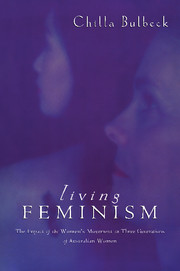Book contents
- Frontmatter
- Contents
- List of Tables
- Preface
- List of Women Who Told their Biographies for the Book
- Abbreviations
- Introduction
- Part One Women's Lives Through A Feminist Lens
- Part Two Present and Future Feminisms
- 5 Finding Feminism
- 6 Is Feminism a White Middle-class Movement?
- 7 Beating the Backlash
- Conclusion
- Appendix 1
- Appendix 2
- Notes
- Bibliography
- Index
6 - Is Feminism a White Middle-class Movement?
Published online by Cambridge University Press: 20 May 2010
- Frontmatter
- Contents
- List of Tables
- Preface
- List of Women Who Told their Biographies for the Book
- Abbreviations
- Introduction
- Part One Women's Lives Through A Feminist Lens
- Part Two Present and Future Feminisms
- 5 Finding Feminism
- 6 Is Feminism a White Middle-class Movement?
- 7 Beating the Backlash
- Conclusion
- Appendix 1
- Appendix 2
- Notes
- Bibliography
- Index
Summary
When we used to have the media, and the government which didn't want to know anything about migrants, things were much more difficult. It was as if migrants are there but they don't really exist, like the Aborigines, I mean they are there but we try not to think that they are there.
(Gladys)When Muslim women in purdah came to the women's movement to request support so that they could meet for their traditional prayer sessions, or non-English speaking background women wanted their children taught their cultural traditions in their mother tongue within the state school system, they received little understanding from Anglo feminism (Kalantzis 1990:40). As Jeannie Martin (1991:126) notes, Anglo feminism often constructed the ‘other’ as victims of greater oppression, offering to ‘help’ them but only if they threw off their patriarchal traditions (Vasta 1991:163). In 1973 Anne Summers suggested that rural women were ‘puzzled by the anti-organization, anti-leadership slogans being parried at them’ from the Women's Electoral Conference in Canberra (Rowbotham 1992:265). Of the nine women firefighters in Carol Finlay's (1994:3,8) study, two ‘discussed the achievements of Germaine Greer’ while the others ‘knew little to nothing about her’, suggesting that their ‘Amazonian concept of femininity’ and their awareness of gender discrimination had come from other sources.
This chapter explores the claim that the women's movement has not only been a mainly urban Anglo middle-class phenomenon – which is probably largely true – but that this is the only constituency which has responded to feminism.
- Type
- Chapter
- Information
- Living FeminismThe Impact of the Women's Movement on Three Generations of Australian Women, pp. 156 - 181Publisher: Cambridge University PressPrint publication year: 1997

